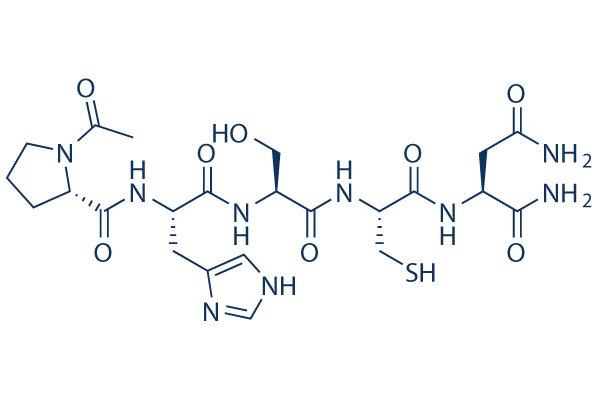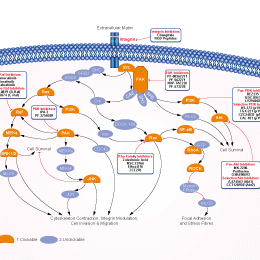
- Bioactive Compounds
- By Signaling Pathways
- PI3K/Akt/mTOR
- Epigenetics
- Methylation
- Immunology & Inflammation
- Protein Tyrosine Kinase
- Angiogenesis
- Apoptosis
- Autophagy
- ER stress & UPR
- JAK/STAT
- MAPK
- Cytoskeletal Signaling
- Cell Cycle
- TGF-beta/Smad
- DNA Damage/DNA Repair
- Compound Libraries
- Popular Compound Libraries
- Customize Library
- Clinical and FDA-approved Related
- Bioactive Compound Libraries
- Inhibitor Related
- Natural Product Related
- Metabolism Related
- Cell Death Related
- By Signaling Pathway
- By Disease
- Anti-infection and Antiviral Related
- Neuronal and Immunology Related
- Fragment and Covalent Related
- FDA-approved Drug Library
- FDA-approved & Passed Phase I Drug Library
- Preclinical/Clinical Compound Library
- Bioactive Compound Library-I
- Bioactive Compound Library-Ⅱ
- Kinase Inhibitor Library
- Express-Pick Library
- Natural Product Library
- Human Endogenous Metabolite Compound Library
- Alkaloid Compound LibraryNew
- Angiogenesis Related compound Library
- Anti-Aging Compound Library
- Anti-alzheimer Disease Compound Library
- Antibiotics compound Library
- Anti-cancer Compound Library
- Anti-cancer Compound Library-Ⅱ
- Anti-cancer Metabolism Compound Library
- Anti-Cardiovascular Disease Compound Library
- Anti-diabetic Compound Library
- Anti-infection Compound Library
- Antioxidant Compound Library
- Anti-parasitic Compound Library
- Antiviral Compound Library
- Apoptosis Compound Library
- Autophagy Compound Library
- Calcium Channel Blocker LibraryNew
- Cambridge Cancer Compound Library
- Carbohydrate Metabolism Compound LibraryNew
- Cell Cycle compound library
- CNS-Penetrant Compound Library
- Covalent Inhibitor Library
- Cytokine Inhibitor LibraryNew
- Cytoskeletal Signaling Pathway Compound Library
- DNA Damage/DNA Repair compound Library
- Drug-like Compound Library
- Endoplasmic Reticulum Stress Compound Library
- Epigenetics Compound Library
- Exosome Secretion Related Compound LibraryNew
- FDA-approved Anticancer Drug LibraryNew
- Ferroptosis Compound Library
- Flavonoid Compound Library
- Fragment Library
- Glutamine Metabolism Compound Library
- Glycolysis Compound Library
- GPCR Compound Library
- Gut Microbial Metabolite Library
- HIF-1 Signaling Pathway Compound Library
- Highly Selective Inhibitor Library
- Histone modification compound library
- HTS Library for Drug Discovery
- Human Hormone Related Compound LibraryNew
- Human Transcription Factor Compound LibraryNew
- Immunology/Inflammation Compound Library
- Inhibitor Library
- Ion Channel Ligand Library
- JAK/STAT compound library
- Lipid Metabolism Compound LibraryNew
- Macrocyclic Compound Library
- MAPK Inhibitor Library
- Medicine Food Homology Compound Library
- Metabolism Compound Library
- Methylation Compound Library
- Mouse Metabolite Compound LibraryNew
- Natural Organic Compound Library
- Neuronal Signaling Compound Library
- NF-κB Signaling Compound Library
- Nucleoside Analogue Library
- Obesity Compound Library
- Oxidative Stress Compound LibraryNew
- Plant Extract Library
- Phenotypic Screening Library
- PI3K/Akt Inhibitor Library
- Protease Inhibitor Library
- Protein-protein Interaction Inhibitor Library
- Pyroptosis Compound Library
- Small Molecule Immuno-Oncology Compound Library
- Mitochondria-Targeted Compound LibraryNew
- Stem Cell Differentiation Compound LibraryNew
- Stem Cell Signaling Compound Library
- Natural Phenol Compound LibraryNew
- Natural Terpenoid Compound LibraryNew
- TGF-beta/Smad compound library
- Traditional Chinese Medicine Library
- Tyrosine Kinase Inhibitor Library
- Ubiquitination Compound Library
-
Cherry Picking
You can personalize your library with chemicals from within Selleck's inventory. Build the right library for your research endeavors by choosing from compounds in all of our available libraries.
Please contact us at [email protected] to customize your library.
You could select:
- Antibodies
- Bioreagents
- qPCR
- 2x SYBR Green qPCR Master Mix
- 2x SYBR Green qPCR Master Mix(Low ROX)
- 2x SYBR Green qPCR Master Mix(High ROX)
- Protein Assay
- Protein A/G Magnetic Beads for IP
- Anti-Flag magnetic beads
- Anti-Flag Affinity Gel
- Anti-Myc magnetic beads
- Anti-HA magnetic beads
- Magnetic Separator
- Poly DYKDDDDK Tag Peptide lyophilized powder
- Protease Inhibitor Cocktail
- Protease Inhibitor Cocktail (EDTA-Free, 100X in DMSO)
- Phosphatase Inhibitor Cocktail (2 Tubes, 100X)
- Cell Biology
- Cell Counting Kit-8 (CCK-8)
- Animal Experiment
- Mouse Direct PCR Kit (For Genotyping)
- New Products
- Contact Us
ATN-161
Synonyms: Ac-PHSCN-NH2
ATN-161 is a novel small peptide antagonist of integrin α5β1. It binds to several integrins, including α5β1 and αvβ3, that play a role in angiogenesis and tumor progression.

ATN-161 Chemical Structure
CAS No. 262438-43-7
Purity & Quality Control
Batch:
Purity:
99.82%
99.82
ATN-161 Related Products
| Related Targets | ILK | Click to Expand |
|---|---|---|
| Related Products | Cilengitide trifluoroacetate Cilengitide SB273005 RGD (Arg-Gly-Asp) Peptides Cyclo(RGDyK) TFA Cyclo(-RGDfK) TFA Leukadherin-1 A-205804 OSU-T315 | Click to Expand |
| Related Compound Libraries | Kinase Inhibitor Library Angiogenesis Related compound Library TGF-beta/Smad compound library Cytoskeletal Signaling Pathway Compound Library Anti-Cardiovascular Disease Compound Library | Click to Expand |
Signaling Pathway
Biological Activity
| Description | ATN-161 is a novel small peptide antagonist of integrin α5β1. It binds to several integrins, including α5β1 and αvβ3, that play a role in angiogenesis and tumor progression. | ||
|---|---|---|---|
| Targets |
|
| In vitro | ||||
| In vitro | ATN-161 interacts with the N-terminus of the β1-domain of integrin α5β1, which may lock this integrin in an inactive conformation[2]. ATN-161 treatment up to 100 μmol/L shows no significant effect on tumor cell proliferation compared with the vehicle-treated control group of cells. However, ATN-161 significantly inhibits MAPK phosphorylation with maximal effects observed at 20 μmol/L of ATN-161 after 30 minutes of treatment[1]. | |||
|---|---|---|---|---|
| Cell Research | Cell lines | MDA-MB-231 cells | ||
| Concentrations | 1-100 μmol/L | |||
| Incubation Time | 15-60 minutes | |||
| Method | MDA-MB-231 (1 × 106) cells are plated in 100 mm Petri dishes for 24 hours, then serum-starved overnight before treatment with vehicle or ATN-161 (1-100 μmol/L) for different time periods (15-60 minutes). Western blot analyses are carried out using antibodies against focal adhesion kinase, phosphorylated FAK, mitogen-activated protein kinase (MAPK), phosphorylated MAPK, and β-tubulin as previously described. Western blots are detected using enhanced chemiluminescence detection reagents. |
|||
| In Vivo | ||
| In vivo | ATN-161 (Ac-PHSCN-NH2), a 5-mer capped peptide derived from the synergy region of fibronectin that binds to α5β1 and αvβ3 in vitro, blocks breast cancer growth and metastasis. Treatment with ATN-161 causes a significant dose-dependent decrease in tumor volume and either completely blocked or caused a marked decrease in the incidence and number of skeletal as well as soft tissue metastases. Treatment with ATN-161 results in a significant decrease in the expression of phosphorylated mitogen-activated protein kinase, microvessel density, and cell proliferation in tumors grown in vivo[1]. ATN-161 is a peptide with a fairly short plasma half-life. compared with the plasma pharmacokinetics of ATN-161, It is cleared from the tumor with much slower kinetics supporting the hypothesis that this peptide exerts its effects through a durable interaction with its target(s)in the tumor[3]. | |
|---|---|---|
| Animal Research | Animal Models | BALB/c nu/nu mice |
| Dosages | 0.05-1 mg/kg/d | |
| Administration | i.v. | |
Chemical Information & Solubility
| Molecular Weight | 597.64 | Formula | C23H35N9O8S |
| CAS No. | 262438-43-7 | SDF | Download ATN-161 SDF |
| Smiles | CC(=O)N1CCCC1C(=O)NC(CC2=CN=CN2)C(=O)NC(CO)C(=O)NC(CS)C(=O)NC(CC(=O)N)C(=O)N | ||
| Storage (From the date of receipt) | |||
|
In vitro |
Water : 10 mg/mL (超声加热十分钟,60℃) DMSO : 3 mg/mL ( (5.01 mM) Moisture-absorbing DMSO reduces solubility. Please use fresh DMSO.) Ethanol : Insoluble |
Molecular Weight Calculator |
|
In vivo Add solvents to the product individually and in order. |
In vivo Formulation Calculator |
||||
Preparing Stock Solutions
Molarity Calculator
In vivo Formulation Calculator (Clear solution)
Step 1: Enter information below (Recommended: An additional animal making an allowance for loss during the experiment)
mg/kg
g
μL
Step 2: Enter the in vivo formulation (This is only the calculator, not formulation. Please contact us first if there is no in vivo formulation at the solubility Section.)
% DMSO
%
% Tween 80
% ddH2O
%DMSO
%
Calculation results:
Working concentration: mg/ml;
Method for preparing DMSO master liquid: mg drug pre-dissolved in μL DMSO ( Master liquid concentration mg/mL, Please contact us first if the concentration exceeds the DMSO solubility of the batch of drug. )
Method for preparing in vivo formulation: Take μL DMSO master liquid, next addμL PEG300, mix and clarify, next addμL Tween 80, mix and clarify, next add μL ddH2O, mix and clarify.
Method for preparing in vivo formulation: Take μL DMSO master liquid, next add μL Corn oil, mix and clarify.
Note: 1. Please make sure the liquid is clear before adding the next solvent.
2. Be sure to add the solvent(s) in order. You must ensure that the solution obtained, in the previous addition, is a clear solution before proceeding to add the next solvent. Physical methods such
as vortex, ultrasound or hot water bath can be used to aid dissolving.
Tech Support
Answers to questions you may have can be found in the inhibitor handling instructions. Topics include how to prepare stock solutions, how to store inhibitors, and issues that need special attention for cell-based assays and animal experiments.
Tel: +1-832-582-8158 Ext:3
If you have any other enquiries, please leave a message.
* Indicates a Required Field
Tags: buy ATN-161 | ATN-161 supplier | purchase ATN-161 | ATN-161 cost | ATN-161 manufacturer | order ATN-161 | ATN-161 distributor







































